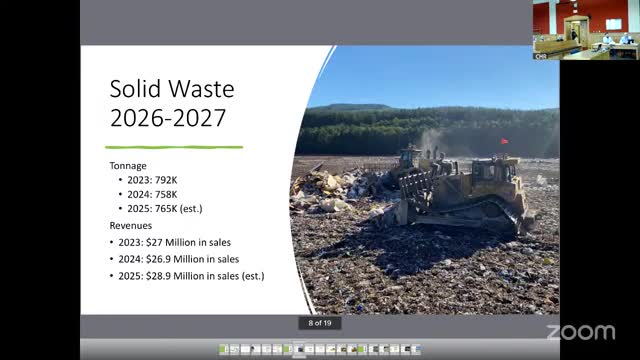Landfill managers report steady tonnage, compacting gains and multi‑million plans for next cell
October 23, 2025 | Cowlitz County, Washington
This article was created by AI summarizing key points discussed. AI makes mistakes, so for full details and context, please refer to the video of the full meeting. Please report any errors so we can fix them. Report an error »

Cowlitz County solid waste staff reported consistent annual tonnage, plans for large capital work and equipment purchases at Wednesday’s Public Works meeting.
The landfill saw roughly 792,000 tons in 2023, 758,000 in 2024 and staff estimated about 765,000 tons for the current year, officials said. "We would kinda like to leave some headroom" under the permitted maximum of about one million tons, staff said, noting the permitted ceiling helps preserve longevity and flexibility.
Why it matters: County officials said consistent tonnage and the outcome of a few large projects — for example a 30–35,000‑ton Port of Longview rail expansion job — materially affect sales and capacity planning and can add roughly $1 million in revenue in a strong year.
Major capital and closure funding: The landfill fund summary shows transfers for capital and closure costs near $9.1 million annually and closure/post‑closure reserves of roughly $34 million for the headquarters site and $9.7 million for the Tenant Way site. Staff said Tenant Way is already 10 years into post‑closure monitoring and that the headquarters site’s closure/post‑closure estimate is currently $34 million. The team also reported the landfill financial projections show life extension into the 2080s (staff used 2082 as a working estimate but noted recovered airspace can extend that date).
Equipment and cell development: Staff requested purchase authority for a new Caterpillar compactor (described as an approximate 130,000‑pound machine) with an estimated cost of a little over $2 million, a used 30‑ton haul truck (estimated $200,000), and a steel drum roller (used) to reduce frequent rental costs. For next cell development, staff estimated the next built cell (cell 10/11 range depending on configuration) at roughly $14 million and said the county plans to push timing to 2027 because current capacity allows extra time.
Operations and landfill life: Staff described frequent compaction as part of operations, reporting a recent survey flight that showed a 10‑foot drop in one active area over six months that recovered airspace. The department uses large compactors (an "836K" model was cited) and said refurbishment of a compactor returns it for roughly 60–70 cents on the dollar compared with new equipment.
Contracts and permitted limits: Staff said long‑term contracts — including a contract tied to the Nippon transaction that extends to 2044 — and short‑term interlocal agreements bring a mix of stable tonnage and opportunistic debris projects. County officials said they try to limit higher‑risk inbound materials (for example petroleum‑contaminated soils) to low single‑digit percentages of tonnage to avoid creating hard layers in the waste face.
Next steps: Staff will bring formal purchase requests and further timing for cell construction back to the Board; they also plan to provide contract expiration schedules on request and continue close monitoring of closure/post‑closure obligations.
The landfill saw roughly 792,000 tons in 2023, 758,000 in 2024 and staff estimated about 765,000 tons for the current year, officials said. "We would kinda like to leave some headroom" under the permitted maximum of about one million tons, staff said, noting the permitted ceiling helps preserve longevity and flexibility.
Why it matters: County officials said consistent tonnage and the outcome of a few large projects — for example a 30–35,000‑ton Port of Longview rail expansion job — materially affect sales and capacity planning and can add roughly $1 million in revenue in a strong year.
Major capital and closure funding: The landfill fund summary shows transfers for capital and closure costs near $9.1 million annually and closure/post‑closure reserves of roughly $34 million for the headquarters site and $9.7 million for the Tenant Way site. Staff said Tenant Way is already 10 years into post‑closure monitoring and that the headquarters site’s closure/post‑closure estimate is currently $34 million. The team also reported the landfill financial projections show life extension into the 2080s (staff used 2082 as a working estimate but noted recovered airspace can extend that date).
Equipment and cell development: Staff requested purchase authority for a new Caterpillar compactor (described as an approximate 130,000‑pound machine) with an estimated cost of a little over $2 million, a used 30‑ton haul truck (estimated $200,000), and a steel drum roller (used) to reduce frequent rental costs. For next cell development, staff estimated the next built cell (cell 10/11 range depending on configuration) at roughly $14 million and said the county plans to push timing to 2027 because current capacity allows extra time.
Operations and landfill life: Staff described frequent compaction as part of operations, reporting a recent survey flight that showed a 10‑foot drop in one active area over six months that recovered airspace. The department uses large compactors (an "836K" model was cited) and said refurbishment of a compactor returns it for roughly 60–70 cents on the dollar compared with new equipment.
Contracts and permitted limits: Staff said long‑term contracts — including a contract tied to the Nippon transaction that extends to 2044 — and short‑term interlocal agreements bring a mix of stable tonnage and opportunistic debris projects. County officials said they try to limit higher‑risk inbound materials (for example petroleum‑contaminated soils) to low single‑digit percentages of tonnage to avoid creating hard layers in the waste face.
Next steps: Staff will bring formal purchase requests and further timing for cell construction back to the Board; they also plan to provide contract expiration schedules on request and continue close monitoring of closure/post‑closure obligations.
View full meeting
This article is based on a recent meeting—watch the full video and explore the complete transcript for deeper insights into the discussion.
View full meeting
